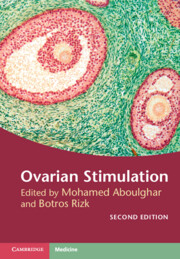Book contents
- Ovarian Stimulation
- Ovarian Stimulation
- Copyright page
- Dedication
- Contents
- Contributors
- About the Editors
- Foreword
- Preface to the first edition
- Preface to the second edition
- Section 1 Mild Forms of Ovarian Stimulation
- Section 2 Ovarian Hyperstimulation for IVF
- Chapter 6 GnRH Agonists for Ovarian Hyperstimulation
- Chapter 7 Role of GnRH Antagonist in Assisted Reproduction
- Chapter 8 Gonadotropins in Ovarian Stimulation
- Chapter 9 Egg Donation: Implications for Counseling Donor and Recipient, Donor Preparation, and Recipient Preparation
- Chapter 10 Progestin-Primed Ovarian Stimulation
- Chapter 11 Ovarian Stimulation in Poor Responders
- Section 3 Difficulties and Complications of Ovarian Stimulation and Implantation
- Section 4 Non-conventional Forms Used during Ovarian Stimulation
- Section 5 Alternatives to Ovarian Hyperstimulation and Delayed Transfer
- Section 6 Procedures before, during, and after Ovarian Stimulation
- Index
- References
Chapter 10 - Progestin-Primed Ovarian Stimulation
from Section 2 - Ovarian Hyperstimulation for IVF
Published online by Cambridge University Press: 14 April 2022
- Ovarian Stimulation
- Ovarian Stimulation
- Copyright page
- Dedication
- Contents
- Contributors
- About the Editors
- Foreword
- Preface to the first edition
- Preface to the second edition
- Section 1 Mild Forms of Ovarian Stimulation
- Section 2 Ovarian Hyperstimulation for IVF
- Chapter 6 GnRH Agonists for Ovarian Hyperstimulation
- Chapter 7 Role of GnRH Antagonist in Assisted Reproduction
- Chapter 8 Gonadotropins in Ovarian Stimulation
- Chapter 9 Egg Donation: Implications for Counseling Donor and Recipient, Donor Preparation, and Recipient Preparation
- Chapter 10 Progestin-Primed Ovarian Stimulation
- Chapter 11 Ovarian Stimulation in Poor Responders
- Section 3 Difficulties and Complications of Ovarian Stimulation and Implantation
- Section 4 Non-conventional Forms Used during Ovarian Stimulation
- Section 5 Alternatives to Ovarian Hyperstimulation and Delayed Transfer
- Section 6 Procedures before, during, and after Ovarian Stimulation
- Index
- References
Summary
The reproductive cycle requires complex interactions and feedback between gonadotropin-releasing hormone (GnRH), the gonadotropins follicle-stimulating hormone (FSH) and luteinizing hormone (LH), and the ovarian sex steroid hormones estrogen and progesterone. To improve the success rate of in vitro fertilization-embryo transfer (IVF-ET) by optimizing oocyte retrieval, controlled ovarian stimulation (COS) has been widely performed. Exogenous gonadotropins were used to achieve supraphysiological levels during the follicular phase to override the process of dominant follicle selection and enable multiple follicular recruitment, which lead to a rapidly increasing serum estradiol level and induce a premature LH surge. GnRH agonist (GnRHa) and GnRH antagonist were used to prevent the premature LH surge and premature ovulation [1]. In 2003, based on ultrasonographic studies, Baerwald et al. demonstrated that multiple cohorts or “waves” of 2–5 mm follicles were recruited continuously during a menstrual cycle, including in the luteal phase [2;3].
- Type
- Chapter
- Information
- Ovarian Stimulation , pp. 93 - 100Publisher: Cambridge University PressPrint publication year: 2022



